Sign of the Times
I had never seen a newspaper vending box that took credit/debit cards as well as coins until I stumbled across this one outside the Crystal City Metro station. So I took a picture of it.
Jason Lefkowitz's forlorn hope

My favorite gang of strategy-gaming Swedes, Paradox Interactive, are observing their 10th anniversary this week, and to celebrate they’re offering 50% off every title in their catalog.
Let me say that again a little louder: you can get the best computer strategy games available for 50% off this week.
The sale prices are being offered on all the major digital-downloading services: Steam, Impulse, Direct2Drive and Paradox’s own GamersGate.
To give you a sense of the bargains that are available, here’s a few titles I highly recommend, along with their sale prices:
Europa Universalis 3 Complete: I’ve written before about how great Europa Universalis 2 was, and the sequel is even better — especially when you add in the Napoleon’s Ambition and In Nomine expansion packs, both of which are included in EU3 Complete. If you love strategy games there is no excuse not to own this title. Metacritic score: 83. Sale price: $13.99.
Hearts of Iron 2 Complete: A deep and rich World War II grand strategy game with a wealth of gameplay options; I’ve been playing this one literally for years without ever getting tired of it. The Complete edition includes all the expansion packs, which let you play a range of alternate-history scenarios, as well as the core game. Metacritic score: 83. Sale price: $12.99.
Crusader Kings Complete: Leap onto the throne of any kingdom of medieval Europe, at any time from 1066 to 1453 A.D., and try to steer your family into ruling the whole continent. Uniquely, and appropriately for a game about medieval kingship, Crusader Kings‘ gameplay centers around managing your family — if your king dies at any point without a suitable heir to take his place, the game is over, so much of the player’s strategy revolves around arranging marriages (and, if need be, Henry VIII-style divorces) to strengthen your family line and place your children in contention for other kings’ thrones. The Complete edition includes the must-have Deus Vult expansion. Metacritic score: 73. Sale price: $12.45.
Mount and Blade: I’ve already sung of my love for this game, so I won’t bother repeating myself. Metacritic score: 72. Sale price: $14.95.
Take Command: Second Manassas: An incredibly detailed game of tactical Civil War combat that lets you lead troops on either side at any level, from a couple of regiments to the entire army. At the grandest scale, seeing entire divisions lurch into combat against each other provides a spectacle unlike any other in PC gaming. Metacritic score: 74. Sale price: $4.99.
Seriously, if you’re at all into these types of games, these are deals you should not let pass by. The sale ends on July 26, so if you want to buy, get to clickin’!
40 years ago today, the first human explorers set foot on another world.
Six years before their fragile craft landed on the Moon, in a speech at Rice University, President John F. Kennedy explained why he was sending them there:
There is no strife, no prejudice, no national conflict in outer space as yet. Its hazards are hostile to us all. Its conquest deserves the best of all mankind, and its opportunity for peaceful cooperation many never come again. But why, some say, the moon? Why choose this as our goal? And they may well ask why climb the highest mountain? Why, 35 years ago, fly the Atlantic? Why does Rice play Texas?
We choose to go to the moon. We choose to go to the moon in this decade and do the other things, not because they are easy, but because they are hard, because that goal will serve to organize and measure the best of our energies and skills, because that challenge is one that we are willing to accept, one we are unwilling to postpone, and one which we intend to win, and the others, too.
Why did we go to the moon? Because it could be done — and because we chose to do it.
Today, as our public discourse sags under the dead weight of tired “leaders” and entrenched interests, all deeply vested in the impossibility of change, all counseling hesitation and prudence and delay, it’s worth remembering that once, not so long ago, within living memory in fact, we disregarded their counsel and chose boldness instead of timidity.
And history was made.
Why? Because we chose to.
UPDATE (7PM): If you want to try your hand at running your own moon program, you might be interested to know that the 1993 DOS game Buzz Aldrin’s Race Into Space (BARIS) — a classic management sim that puts you in charge of either the American or Russian space program in 1957, and challenges you to beat your opposite number to a lunar landing — has been open sourced, so you can now download and play it free of charge on Windows and Mac (and presumably on Linux too via WINE, though I haven’t tried that yet).
BARIS is a tough game to beat — every move requires striking the right balance between pressing for fast progress and avoiding losing your astronauts and spacecraft to accidents — but if you like strategy games, you’ll burn up plenty of hours with this one. (Hat tip to Rock, Paper, Shotgun for bringing this to my attention.)
So, you know, go overthrow yourself a tyrant or something.
Everybody’s favorite paleocon, the War Nerd (of whom I have written in appreciation before), posted his latest opus a couple days ago on the subject of the Battle of Gettysburg — or, more specifically, paintings of the Battle of Gettysburg:
The fight at Gettysburg was the cleanest, finest fight ever in the world. That’s why I grew up just staring for like hours in hot afternoons in my room at those paintings. You know the Gettysburg paintings I mean? If you do, you probably know them the way I did before I started looking up stuff for this article: you know the paintings by heart but don’t much know or care who made them. As a kid I bet I could’ve drawn a decent replica of my favorite, the one with rebs and Yankees fighting hand-to-hand along a rail fence. I remember how the guy who painted it imagined the moment when the first line absorbs and infantry charge, the perfect way the main body of the attack is already sweeping past with the stars and bars high, but some of the Fed defenders have survived and a fraction of the Rebel attackers has to stop to deal with them, mop up. Every single hand-to-hand combat is so perfect.
He ends his post with a lament that despite hours of Googling, he can’t find that painting he remembers anywhere on the Web.
As I read that, I thought Aha! The War Nerd may not know where to look for his painting, but I do! That’s because there’s one painter in particular whose name is practically synonymous with paintings of Civil War battles — Mort Künstler.
Künstler, whose Web site modestly describes him as “the premier historical artist in America,” is a favorite artist among those who like history more than they like art. He’s made a bit of a mini-industry out of painting Civil War scenes — which his site, in another fit of uncontrollable modesty, describes as “masterworks” — usually with a bit of romantic Lost Cause Confederate nostalgia for frosting.
Which wouldn’t be a problem if his paintings were any good. But for the most part, they are not.
Künstler’s problem is that he appears not to know how to paint human beings. Oh, he gets the broad strokes right — his subjects generally have the right number of limbs and orifices (at least as far as we can tell, given that they’re wearing uniforms). But there’s always some detail that makes you scratch your head and think “wait a minute, human beings don’t look like that.”
Consider, for instance, his painting “Eve of Battle,” in which he manages to capture one of my personal heroes, Union general John Buford, striking a pose that’s startling in its unlikeliness:

The problem with this painting is that I’m not sure if the subject is supposed to be walking or standing still. Buford’s legs are splayed wide, as if caught in the midst of a purposeful stride, and the heel of his left foot is raised off the ground; but his upper body appears relaxed, at rest. It’s weirdly dissonant. Human beings don’t move like that.
For a more dramatic illustration, I give you Künstler’s “The Lincoln-Douglas Debates,” in which he manages to turn both Abraham Lincoln and Stephen Douglas into bizarre animatronic simulacra:

The perspective on this one is so weird I fear it can induce dizziness. You may want to pop some Dramamine before staring at it for too long, just in case.
Want another example? Too bad, you’re getting one. This treacle tart is titled “Especially for You“:

All I have to say about this one is that the faces on the little girl and her mother terrify me. They look like mannequins possessed by Evil Spirits, condemned to wander the Earth for all eternity as punishment for sins too terrible to name. Which I’m pretty sure is not the response Künstler was shooting for.
Anyway, the War Nerd’s column got me digging through Künstler’s site in hopes of finding the particular painting he was jonesing for. I didn’t find it, alas. But I did find something that shocked me to the core: evidence that, at one point, Mort Künstler was actually (gasp!) a decent artist.
See, when I went past Künstler’s official site and started digging around his Wikipedia entry, I discovered that, before he became the Thomas Kinkade of the re-enactor set, Künstler paid the rent by working as an illustrator-for-hire for a range of magazines — including the “men’s adventure” pulp magazines of the 1950s and early ’60s.
“Men’s adventure” books were a less-slick, more-macho Greatest Generation version of Maxim or FHM; designed to appeal to men’s less… ahem… refined instincts, they typically featured a mix of action (hard-boiled war or adventure stories), soft porn (cheesecake pin-ups and stories of Ravished Women In Distress that were racy by 1950s standards), and ads for “self-improvement” products like Charles Atlas bodybuilding courses. Titles like For Men Only and Stag made it clear what you’d find inside.
The twin shocks of the social revolutions of the 1960s (which made the “men’s adventure” vision of hard-bitten, gun-toting masculinity seem impossibly quaint) and the Vietnam War (which killed the market for stories of upright, selfless G.I.s mowing down hordes of Evil Foreigners) put the “men’s adventure” genre into its grave. And, as James Lileks reminds us, it also didn’t help that the magazines themselves kind of sucked:
As soon as I’ve scanned everything I plan to burn it all. It’s that’s creepy. It’s that sad. It’s that pathetic. These aren’t nudie mags in the usual sense – probably because there’s usually no nudity. Just capering cuties in grainy black-and-white making the clichéd “you’ve caught me in my nightie!” face. The stories are bombastic but empty, always exposing something or other – sin, vice, sinful vice. Typical tales: “The Harlots of Des Moines!” or “Girls For Sale in Sex-Drenched Dusseldorf!” And there’s always a Nazi story. In every issue, Nazis. Why? Because a large part of the target demographic had spent its youth whipping Nazi butt, I suppose. And another part of the demographic really got off on Nazis, one fears.
But in spite of all that, for a couple of decades it was a thriving corner of the pulp publishing universe. And it paid Mort Künstler’s rent.
I don’t bring this up to giggle at the idea of “the premier historical artist in America” illustrating stories with titles like “The Harlots of Des Moines.” I bring it up because some of Künstler’s work from that period is — dare I say it? — pretty good.
A gallery of some covers of men’s adventure covers painted by Künstler makes the point pretty effectively. They’re not high art, but many of them are alive in ways that his later, more reverent historical work simply is not. Let’s take a look at a few of them, which I reproduce here with the gracious permission of the American Art Archives.
Consider this cover, which in a just world would be what you’d find when you look up “MALE” in the dictionary:

Look at that! You may think you’re tough, Jack, but when was the last time you got into a fistfight with an octopus the size of a full grown man? But that’s just what our hero is doing — and all while looking cool with awesome ’60s shades and a couple days’ worth of stubble. And the texture of the octopus’ skin is perfect — slimy and scaly looking.
It’s about as perfect an illustration as you could imagine for the story title given: “The Strangler Came Out of the Sea!” Goddamn right it did — and then I fucking speared it in the eye! Now that’s how you spend a weekend.
But, as noted above, the men’s adventure pulps weren’t all octopus wrestling; they had to work in plenty of cheesecake as well. Here too, Künstler delivered:
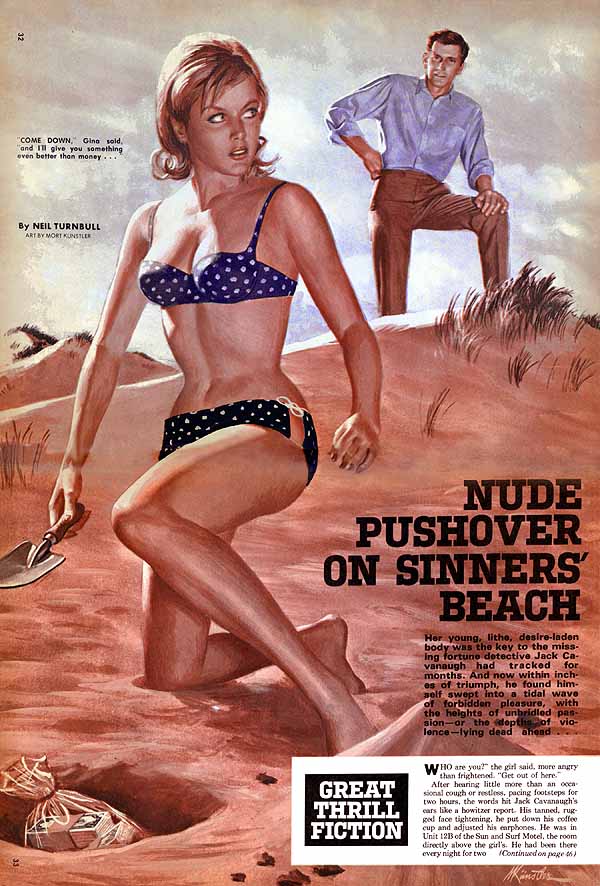
Let’s concede right up front that the gentleman staring down at Miss Moneypenny here isn’t rendered particularly well. In fact, he looks practically unfinished; as if Künstler hastily sketched him in ten minutes to deadline.
But that’s because nobody reading this magazine gave a damn about the guy. They’re reading it for the babe. And the babe is rendered perfectly, from her figure (lush and curvy, but not comically exaggerated) right down to the little details like the look in her eyes — here she had set aside her whole afternoon to dig up buried treasure on Sinners’ Beach (!) in a skimpy bikini, and now this guy has the cojones to interrupt her with his lame-ass pickup lines? You can see from her knitted eyebrows and pursed lips what she’s thinking — “I wonder how many times I’d have to hit this chump with my trowel to put him and his Sansabelt slacks out of their misery?”
This is not your standard Damsel in Distress. This woman is a stone cold killer. Get between her and her dough and you’re gonna get murdered with some kind of gardening implement.
So young Künstler could handle action scenes, and he could handle cheesecake scenes. But what if you wanted some action mixed in with your cheesecake? They are, after all, two great tastes that taste great together. Well, never fear, he had your back there too:
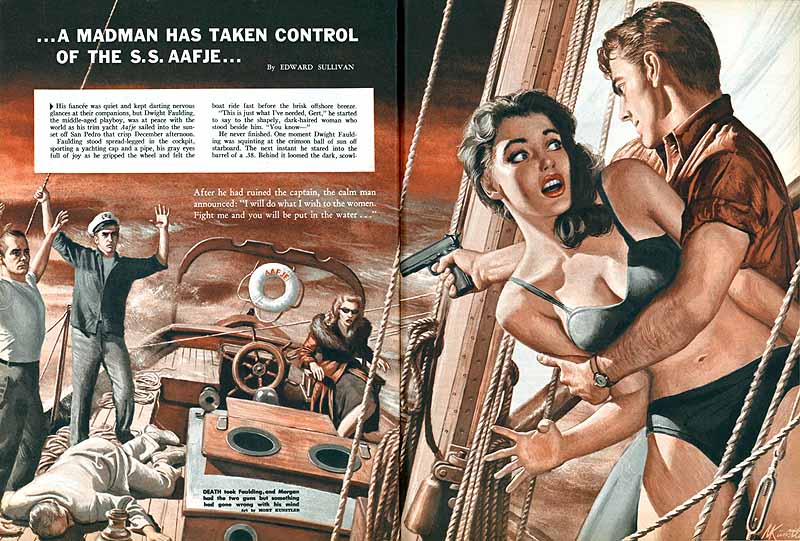
Pirates! Armed madmen seize control of your boat — and the only weapons you have to fight back with are your trusty .45, your manly jawline, and your (bikini-clad, natch) secretary. What do you do? What do you do?
(Well, you shoot them, of course. They are madmen, after all; that’s a job description that has “don’t bother negotiating with me” written all over it. But be sure to tote the secretary around while you’re doing the shooting, that’ll really help your aim.)
And if you want to leave the realm of plausibility behind completely? Say, with a story about wild gangs of outlaw surfers out for kicks?

Child’s play! You can almost hear Künstler’s derisive snort when he was handed the assignment. “‘The Hell Surfers?’ Hey, wake me when you’ve got a real challenge.”
Browse through the rest of the gallery and you’ll see what I mean. These illustrations aren’t the Mona Lisa, but they have a style to them that Künstler’s historical work completely lacks. They feel so much more human, so much less weighted down. It’s as if the artist was liberated by the fact that his subjects were so thoroughly tawdry — as if, without the burden of depicting Great Personages, he could just let his imagination run wild.
And occasionally, he could even come up with one that was downright poignant:

Yes, it’s an illustration for an icky domination fantasy about a German woman who’s reduced to whoring herself out to G.I.s for chocolate bars and Lucky Strikes after Allied bombers burn her city to the ground. But put that aside for a second and look at the composition: the way the red flames of the burning city turn into the tendrils of her hair and the blush of her cheeks, the way her eyes look toward the sky — towards the place from which death rains down, true, but also towards redemption, towards Heaven. It’s a much better piece of work than it has any right to be.
So why did I bother writing all this up? Because I was struck by the sad irony of it all. Künstler’s pulp work is so interesting, but it hardly made him rich, and it definitely didn’t make him famous. Today, though, he is both — but the work that made him so is strikingly less accomplished, less compelling, than the stuff he was churning out for pennies for the front covers of trashy magazines decades earlier.
Was this the result of a conscious compromise — a decision made somewhere along the line to focus less on the art and more on the marketing? Or was it something that he slid into gradually, over many years? Is he happier now that churning out crap has made him “the premier historical artist in America” than he was when he was sketching out octopus fights in a garret for beer money? Or does he secretly miss those days when he was free to churn out wild flights of fancy in bold colors without anyone in the world knowing his name?
There’s a great story hidden away in there, somewhere.
Most normal people get spam about boner pills. I get this:

The only possible conclusion: a marketing program somewhere in the world has decided that I’m more likely to be building an atomic bomb in my basement than I am to be getting laid.
All men dream: but nor equally, Those who dream by night in the dusty recesses of their minds wake in the day to find that it was vanity: but the dreamers of the day are dangerous men, for they may act their dream with open eyes, to make it possible.
Seen today on an Amazon.com page extolling the virtues of Vista Home Premium Edition:

Home Pemium?
If you’re going to take your cellphone with you on a kayaking trip, make sure that the waterproof bag you stow it in is actually waterproof.
In other news, I bought a new Pre smartphone this morning.
I will leave it as an exercise for the reader to determine how these two news items are connected.
As far as I’m concerned, if you are the co-creator of something as insanely cool and useful as Flickr, you’d be completely within your rights to spend the rest of your life dining out on that accomplishment alone. (Hell, people have spent their lives dining out on a lot less.) So when I heard that Flickr co-founder Caterina Fake was launching a new product today, I was eager to give it a spin.
The new product is called Hunch, and Fake describes it as a “decision engine,” probably to avoid the mistake that Cuil made of pitting themselves directly against the Google monolith. (That kind of comparison sets up expectations that any startup would be hard pressed to meet.) A better term for it, though, might be “guided search” — the way it works is that you put in question you want an answer to, and then Hunch asks you some other questions to identify exactly what you’re looking for, and then it brings back a recommendation based on your answers. The more frequently you use the site, it promises, the better it will get to know you, and the more accurate its results will be.
It’s a clever idea, and the few test queries I ran through it were returned with decent answers. But my first impression of the service was actually incredibly negative — and it wasn’t until hours later that I realized why.
Here’s what you see when you visit Hunch for the first time:
My annotations are in red; I put them there to illustrate how Hunch’s interface led me astray.
See, when you first visit Hunch, the first thing you notice is the ginormous front-and-center box asking you a simple question — in this case, “Where is your home located?” The whole schtick of the site is that it “learns” your preferences, so naturally you figure the way to start using it is to answer the question. So you do…
… which results in another simple question (like “do you prefer to work with numbers?” or “What type of French fries do you prefer?”) being asked. Answer that, and you get another. Answer that, and you get another. And on and on.
After you’ve answered five or six questions, you start to wonder where the hell the actual application is. You’re not there to answer questions, you’re there to get answers to questions. And yet Hunch just keeps asking and asking without giving anything back to justify why you’re spending all this time answering trivia questions about yourself — there’s no progress bar, no “you’ve answered 5 out of 15 questions!” notice; it’s just Questions Without End, like a blind date from hell. I eventually got frustrated and clicked away.
It wasn’t until much later that I realized what I had been missing — the trivia questions about yourself are entirely optional. You can get right into the meat of the application — the guided search process — by typing a question into the search box in the top right corner of the page. This search box is how you get into the “funnel” which has the answers you seek at the other end. But it’s waaaay too easy to miss, because:
This is a shame, because it makes it far too easy for new visitors to get led off down the garden path of answering questions about themselves. That might help Hunch “tune” itself to their preferences better, but that only matters if they become long-term users; and they will only become long-term users if the site’s first impression is strong enough to bring them back a second time. Getting them into the guided search funnel makes that strong first impression; the trivia questions do not. So having them front and center is a huge mistake; it hides the very thing that makes Hunch immediately useful.
This could be remedied simply by moving the search box down from the top right into a more prominent position, like so:
(Pardon the not-quite-perfectly-matched-up colors on some of the lines; this is a quick edit hacked together in Paint.NET in five minutes. But you get the idea.)
You wouldn’t have to have the search box in this position on all pages; once the user chooses one of the two funnels (the guided-search funnel, or the tell-us-about-yourself funnel), it could move back up to the top right. And for returning users (people who’ve already created an account, or who have the site’s cookie set), it could go up there on the home page too. But for new users, to make that critical first impression, you want to make it as easy as humanly possible for users to discover what it is you’re offering; and the personal questions don’t do that, the guided search does. So anything that gets them into the guided search funnel is a Good Thing, in my opinion.
And with that, I will stop offering unsolicited advice to the designer of one of the most famously usable Web applications ever designed, before the gods decide to punish me for my arrogance and I spend the rest of eternity condemned to pushing a boulder uphill, or reading TechCrunch, or some other horrible fate.
UPDATE (June 16): Caterina graciously takes the time to respond, and to share some of the thinking that went into Hunch’s UI, in the comments.
If only I could remember why I voted that way…

Oh, yeah, that’s why.
UPDATE (June 10): So did a lot of other people, apparently.
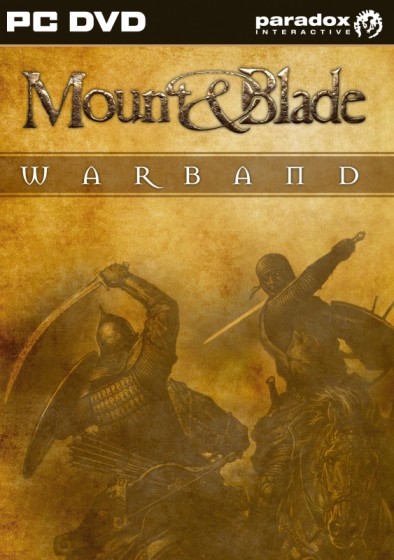
I’ve told you before about my undying love for indie game Mount & Blade. So it’s exciting to see that at the E3 gaming convention in Los Angeles this week, the game’s developers pulled back the curtain on a new expansion pack, Mount & Blade: Warband, which adds a ton of new features — including online multiplayer.
You heard me. With Warband, you won’t be limited to skirmishing against the computer — you’ll be able to take part in massive 64-player online battles. And there’s a bunch of other cool stuff as well:
Key features revealed for the first time at E3:
- Overhauled graphics; HDR, FSAA, Depth of Field, Soft particles, Tone Mapping and many other effects are all now implemented.
- Majority of Models are being redone.
- Multiplayer battles can now handle up to 64 players with Mods including ‘Team Death Match’and ‘Search & Destroy’.
- Ability to become the ruler of a faction and convince lords to become your vassals in the Single Player Campaign.
- Ability to upgrade your companions to vassalage by granting them land.
- Improved Mechanics for Soldier Morale: Soldiers will break and run away if their morale gets too low.
A summary of additional features previously revealed at GDC are Multiplayer for up to 32 players, improved strategic AI, improved graphics and optimization including customizable quick battles, extended diplomatic options and new weapons, armor and animations, a new faction with unique troops and equipment.
Other aspects introduced in Mount&Blade: Warband are improvements to the combat system with more physically accurate horse archery, a variation in horse sizes, and more options when embarking on sieges.
This is rapidly shaping up to be a must-buy.
If you haven’t played Mount & Blade yet, what the hell are you waiting for? There’s a free trial for download that lets you play the full game until your character reaches level 7, and the full game only costs $29.95 to download, no trip to the store required. So being cheap and/or lazy is no excuse here, people. Get to it! You can thank me later.
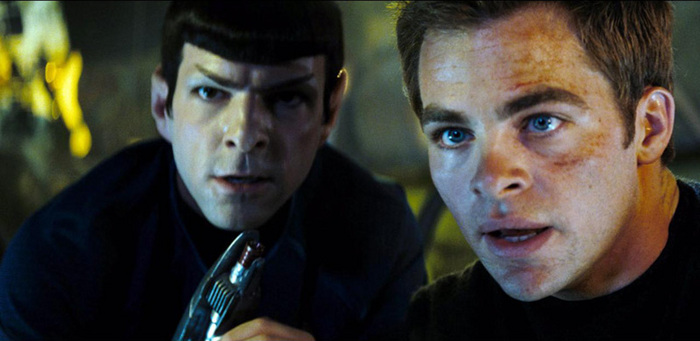
Since tomorrow will see the opening of the much-ballyhooed remake of Star Trek, we’re probably going to be hearing a lot of bellyaching this weekend about how They Don’t Make Anything Original Anymore, Hollywood Is Out of Ideas, etc. etc. etc. So I thought I’d take a moment to offer a contrary opinion.
The short version: remakes aren’t bad. They’re good, and the world would be a more interesting place if we had more of them, not less.
The key to understanding why is this — don’t think about the movies. Think about the theater. Not the movie theater, but the art of live performance on stage.
Plays have been being “remade” for pretty much all of human history. Shakespeare’s works have been mounted on stages around the world for hundreds of years; the works of Euripides, for thousands. In most of these cases the texts are unchanged from the original productions, or at least they are as close to those originals as time and translation will allow.
So where is the howl of protest about how the stage is out of ideas?
It doesn’t exist, for a simple reason — new productions of old texts actually add something to our understanding of those texts. A new director and new actors can take old words — even words that millions know by heart — and put an entirely new spin on them. And by doing so, they can force us to re-examine what we think about the play, and indeed about the world at large.
To see what I mean, one can turn to the early career of Orson Welles. He’s best remembered today for his monumental films like Citizen Kane and The Magnificent Ambersons, but before he went to Hollywood he earned his early fame on the New York stage of the 1930s, mounting visionary productions of Shakespeare classics that took the well-known plays and turned them into commentaries on contemporary social issues: a 1936 Macbeth showing the absurdity of segregation by offering an all-black cast before a backdrop of Haitian voodoo; Julius Caesar reimagined in 1937 as a warning about the rise of fascism, the noble Romans clad in Mussolini-style military uniforms.
One could have asked Welles why he didn’t instead busy himself writing new original scripts rather than re-imagining Shakespeare; but that would have been missing the point. Welles’ productions took on additional power because they were remakes. The politics of the Roman Republic were matters of life and death to the men who took part in them; today, though, they’re matters of academic interest. By picking them up and placing them in a modern context, though, Welles accomplished two things: first, he made them real to contemporary audiences by plundering the symbology of 1930s international politics, which by 1937 were clearly building to something ominous; and second, he showed how Shakespeare’s points about power and ambition are just as true in the modern world as they were in Elizabethan England.
That’s the power of a good remake: by taking something we know and showing it to us from a different angle, it can prompt us to see things in it we had never seen before.
Costuming is just one way a theatrical remake can create that effect; another is casting. Consider the character of Hamlet; over the last century and a half it has been played on stages around the world by a who’s who of the world’s greatest actors: Edwin Booth. John Barrymore. Laurence Olivier. John Gielgud. Kenneth Branagh. Each brought his own interpretation, his own understanding, to the character; each told the familiar story in a way that opened the audience’s eyes anew.
And yet people still complain that it’s sacrilege to have anyone other than William Shatner play James T. Kirk? Give me a break.
Will the new Star Trek be any good? Will Chris Pine‘s performance as Captain Kirk be as memorable as the ones Shatner could occasionally offer? I have no idea.
Not all remakes of Shakespeare are brilliant, after all. Sure, Olivier played Hamlet:
.. but so did Mel Gibson:
… and God knows how many bad Hamlets have graced the stages of high schools and community theaters across the fruited plain. So just because it’s a remake doesn’t mean it’s automatically good.
But — but — it doesn’t mean it’s automatically bad either. All it means is that it’s part of a tradition as old as art itself; one that has, all told, enriched our collective cultural life immeasurably. The interpretations of the geeks and Gibsons are, after all, quickly forgotten; those of the brilliant Oliviers add new layers to the work, layers that can survive long after the actor himself has passed.
Can the same magic happen in film? I don’t see why not. Even when the source material is dreck, a gifted director, writers and cast can turn it into something special; just compare the original Battlestar Galactica to the recently concluded re-imagined version to see what I mean. The former is kitsch; the latter is art.
If it can happen on the small screen, it can happen on the big screen, too. The studios just need to stop looking at remakes as a way to squeeze some quick cash out of a played-out property and start looking at them as ways to create new blockbusters by bringing fresh perspectives to classic stories. All it takes is to bring some imagination to the table.
Rep. John Boehner, the top-ranking Republican in the House of Representatives, was on ABC’s This Week on Sunday and managed to say so many factually wrong things in the course of a single minute that I was kinda stunned.
STEPHANOPOULOS: So what is the responsible way? That’s my question. What is the Republican plan to deal with carbon emissions, which every major scientific organization has said is contributing to climate change?
BOEHNER: George, the idea that carbon dioxide is a carcinogen that is harmful to our environment is almost comical. Every time we exhale, we exhale carbon dioxide. Every cow in the world, you know, when they do what they do, you’ve got more carbon dioxide. And so I think it’s clear…
STEPHANOPOULOS: So you don’t believe that greenhouse gases are a problem in creating climate change?
BOEHNER: … we’ve had climate change over the last 100 years — listen, it’s clear we’ve had change in our climate. The question is how much does man have to do with it, and what is the proper way to deal with this?
Where to begin?
All these weird assertions would be easier to take if they were being spouted by some random person on the street, but John Boehner is the Republican leader in the House of Representatives, which means his opinions have a direct bearing on climate policy in this country.
And yet, he appears to not even understand the most basic facts on the subject — stuff that we routinely expect junior high school kids to grasp.

Nine months ago, I told you that netbooks were the future of the PC industry.
Today the New York Times tells you the same thing:
Get ready for the next stage in the personal computer revolution: ultrathin and dirt cheap…
So far, netbooks have appealed to a relatively small audience. Some of the devices feel more like toys or overgrown phones than full-featured computers. Still, they are the big success story in the PC industry, with sales predicted to double this year, even as overall PC sales fall 12 percent, according to the research firm Gartner. By the end of 2009, netbooks could account for close to 10 percent of the PC market, an astonishing rise in a short span.
Just Well Mixed: the place to come to read about the things everyone else will be reading about next year.

It’s never a good thing when one of your consumer electronics doodads dies smack in the middle of a format transition.
I’ve been rediscovering this timeless bit of wisdom now, because my DVD player recently died. This was a bigger disappointment than you might think. See, when I built my current home theater system nearly a decade ago, the early-adopter gene passed on to me by my Dad drove me to buy the best DVD player then available — the Denon DVD-2800. The DVD-2800 was a hulking beast of a machine that offered a feature that had previously been available only in players costing many thousands of dollars — progressive scan playback, a feature that (on an HDTV) provides the maximum possible picture quality you can get from a DVD.
To get this superior performance, I paid an (ahem) superior price: $700! That still seems like a lot of money to me now, so you can imagine how much it felt like back when I was still making just-out-of-college money. But compared to other progressive-scan players at the time, $700 was a bargain; the DVD-2800’s picture quality surpassed players costing $2,000 and up. So I sucked it up and told myself that I was buying a fine piece of gear that would keep me happy for many years to come.
And so I was. But now the DVD-2800 is dead, and I’m stuck with the question: what comes next?
If I wanted to just buy a straight replacement for it, I could do so for practically nothing. The feature set that seemed like a steal at $700 back in 2000 is now available for $50 plus tax. They practically give the damn things away in cereal boxes.
But, there’s a reason why decent DVD players are so cheap — the high-definition DVD wars are finally over, and we know now what The Future looks like. Blu-Ray Disc offers picture quality that blows plain old DVD (even when progressive-scanned) out of the water, and now that its primary competitor, HD-DVD, is dead, it’s clear that the home video market is settling into two segments: Blu-Ray for obsessives like me, and DVD for everyone else.
Thing is, though, going Blu isn’t cheap. Decent Blu-Ray players start at $300 and spiral upwards from there, just like DVD players did back in the day. And that’s not the only cost associated with Blu; your old DVDs will look the same on a Blu-Ray player as they do on a good progressive-scan DVD player, so to get anything out of your new Blu-Ray player you have to buy your movies over again in Blu. And for maximum quality you need a “1080p” HDTV, which I don’t have (again the early adopter gene bites me in the ass; the TV I bought at around the same time as the Denon DVD player tops out at 1080i).
Naturally, in a few years decent Blu-Ray players will be cheap and plentiful, just like progressive-scan DVD players are today; which is why I had figured I would wait a few years before going Blu, letting someone else pay the early-adopter premium this time. But now I need to buy something or else resign myself to never watching a DVD for however many years that takes.
So this is my question: is $300 a low enough price point, do you think, to make it worth trying to “future-proof” by going Blu? Or does it make more sense to just spend $50 on another DVD player and wait for Blu to get cheaper? The cheap-ass side of me screams that it makes no sense to shell out extra for Blu until I also have the cash to buy new discs and a new TV that can really make use of it — not to mention that, unlike the days of dot-com giddyness when I bought the DVD-2800, the Current Unpleasantness argues against extravagance of any kind. The early-adopter in me, however, screams back that if you’re eventually going to end up going Blu anyway, you may as well put the $50 towards that now rather than wasting it on a DVD player you’re just going to throw away in 6 or 12 or 18 months.
Have any of you gone Blu yet? What do you think?
UPDATE (March 24): In the comments, my friend Oscar asks a good question: why not split the difference and get an “upconverting” DVD player, like the outstanding units made by OPPO Digital?
(For reference, an upconverting DVD player is a player that uses some clever software to take your regular DVDs and display them in near-HD quality. This process is also referred to by some manufacturers as upscaling. It doesn’t look as good as Blu-Ray, but you don’t have to re-buy the movies, so it’s much more economical; and upconverting players are priced in the sweet spot between plain-old-DVD and Blu-Ray, usually running an affordable $100-$150.)
It’s a good suggestion, but it doesn’t work for me because of another way I got bit in the ass by the early-adopter gene. Permit me to explain.
See, when HDTV was first standardized, the electronics industry decided to use what are called “component video” cables to connect HDTVs to HD video sources. This made sense because component offered the highest-quality connection available. So for several years, every HDTV that was sold was sold with component plugs on the back.
Then in the early 2000s, the movie and TV production industry had one of its periodic shit fits about Evil Hackers, and the source of their nightmares was all those TVs with component plugs on them.
Component cables, you see, are “dumb” cables — they just pass the signal along from point A to point B without monkeying with it. To the copyright cartel, this was a terrifying prospect, because it meant you could do things like (gasp!) record the signal onto a videotape. And if people could easily record and share HDTV broadcasts, they feared, they would stop buying movies and TV shows on disc in favor of getting them from the Evil Hackers for free.
The solution, they decided, was to come up with a new cable — called HDMI — that encrypted the signal so that it couldn’t be recorded. And then to use their monopoly over high-profile content to force the electronics industry to ditch component in favor of their new, “protected” connection.
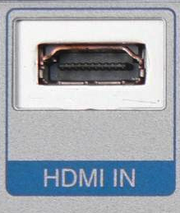
It mostly worked. HDMI is now the standard connector for home theater devices. But people who bought HDTVs before the big shift to HDMI — like, say, me — found that our TVs had instantly become near-obsolete, because you can’t plug things into them anymore without having the things you plug in suddenly lose huge chunks of functionality.
Take upconverting DVD players. They all require you to connect the player via HDMI in order for the upconverting feature to be activated. Most still come with component plugs as well, but if you connect to your TV using those, all the fancy upconverting software gets switched off — and you’ve essentially got a $50 DVD player, only you paid $150 for it.
In most cases this would be a simple matter of just buying an adapter and putting it in between your TV and your player. But because the push for HDMI was driven by a perceived need for copy protection, adapters don’t work; if they did, the Evil Hackers would use them to get around the encryption. So for the fancy upconverting features to activate, your entire connection from the player to the TV must use HDMI cables.
Which means if you don’t have any connectors for HDMI cables on your TV, then you’re kind of boned. Your only option is to buy a whole new TV.
So that’s why I haven’t been considering upconverting players. The HDMI problem isn’t unique to them — Blu-Ray players don’t give maximum 1080p resolution unless you connect them via HDMI, for example — but you can still get 1080i out of them via component, which isn’t too bad as a stopgap. But buying an upconverting DVD player as an interim measure makes little sense if you can’t make use of the one thing that makes it more appealing than a cheap-o plain Jane DVD player. And I can’t.
All of which explains in part why I hate copy protection schemes with a burning fury — because they end up screwing legitimate users like me, without particularly inconveniencing the Evil Hackers they are supposed to hurt. I will have to go spend thousands of dollars on a new HDTV at some point just to get the Magic Connectors that eventually will be required to hook up anything, for no reason other than reassure some rich studio executives that their business model isn’t borked. That’s fucked up no matter how you look at it.
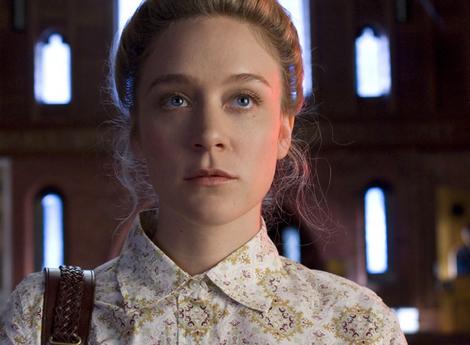
Chloë Sevigny as Nicki Grant in Big Love
I don’t know if you have been watching HBO’s Sunday-night drama series Big Love, but if you haven’t been, you really should be.
Now in its third season, the show has recently generated some controversy with its portrayals of its main characters, a polygamist family from a splinter group of Utah Mormons, but that’s not why I’m recommending you check it out. I’m recommending you check it out for actress Chloë Sevigny‘s portrayal of one of the family’s three wives, “sister-wife” Nicki Grant. Sevigny’s performances on this show have been one of the finest examples I’ve ever seen of how an actor can shape the audience’s perceptions of a character through their performance.
If you were just reading the script for a given episode of Big Love, you’d probably think that Nicki Grant was a bitch on wheels, a woman without a single redeeming characteristic whose narcissism and inflexibility threaten to destroy her entire family. And you’d be right; as written, Nicki is those things. She’s not a very empathetic character.
But Sevigny brings such nuance and humanity to her performance that it changes before your eyes from a two-dimensional stereotype into something much more human. It’s not a case of the “lovable rogue” (think Robin Hood or Han Solo) or any of the other wheezy stereotypes of drama; Sevigny’s Nicki is far from lovable. But Sevigny brings to her performance an approach that teases out nuance from a character that otherwise would have none. Nicki was raised on an isolated compound of fundamentalist Mormons, and Sevigny plays her as half-woman, half-girl, tough as nails but with an incomplete, simplistic understanding of how the world works; just when you think her character is irredeemable, Sevigny finds a note of humanity in a gesture, a look, that stops you in your tracks and reminds you that there’s a person — a deeply wounded person — underneath all of Nicki’s armor.
Anyway, it’s a great performance, one that’s deserving of awards, and you if you’re interested in the craft of acting you could do a lot worse than to tune in and watch how a master does it.
Big Love airs Sunday nights on HBO at 9PM Eastern. The Season 3 finale airs next Sunday, March 22. If you want to start from the beginning, seasons 1 and 2 are available on DVD.
First it was Tucker Carlson, and now it’s Jim Cramer…
Part one:
Part two:
Part three:
I’m in awe.
I need someone with a Google Chat account who can work with me to figure out why my Jabber server isn’t properly federating with GChat. If you’ve got a GChat account and don’t mind me pinging you with a few “Testing 1-2-3” type IMs, send me an email with your GChat username. Thanks!

In 1993, Bill Hicks — one of the truly great American comic geniuses — made his twelfth appearance on The Late Show with David Letterman and delivered a monologue that the Letterman staff considered so controversial that, after taping was complete, they cut Hicks’ entire appearance out of the show.
This was a Big Deal. Letterman had never censored a comic before, and had earned a reputation by doing years of boundary-pushing comedy himself as someone who was friendly to edgy acts. So to completely excise Hicks’ set from the show after the comic had finished taping and left the studio, rather than, say, flagging the problems with it and working with Hicks to work them out, struck a lot of people (including Hicks) as being a pretty severe kind of sell-out.
Here’s a cable access TV interview Hicks gave shortly afterwards, in which he discussed the incident:
Hicks’ set from that show was never aired, that night or ever again. And when Hicks died of cancer just months later at the too-young age of 32, the Letterman set became a part of his legend — a Lost Performance that would never see the light of day.
Until now. Fifteen years after turning the lights out on Hicks, The Late Show has announced that they will be airing the infamous set this Friday:
As is the case with many trailblazers, Hicks’ material was also controversial. In 1993, the Southern satirist became the first comedy act to be censored at CBS’ Ed Sullivan Theatre. Hours after delivering a routine for The Late Show with David Letterman, the show’s executive producer called to tell him it wouldn’t air. Tragically, Hicks died of cancer less than five months after the incident. He was 32.
On Friday, Bill Hicks’ mother will appear on The Late Show to discuss her son’s legacy. Letterman will also air the censored performance, which includes riffs on pop culture and social issues. (For an early peek, read a transcript of the routine.)
So if you want to see a bit of comedy history fifteen years too late, tune in to CBS this Friday night at 11:30 Eastern/Pacific.
UPDATE (Jan. 29): I just realized that I have now lived a longer life than Bill Hicks did. So if you think there’s any kind of justice in the universe, forget it.
On December 9, facing the prospect of a mandatory upgrade to the controversial KDE4 if I upgraded to the latest version of Kubuntu, I asked for someone to “talk me down” from ditching KDE for GNOME:
Supposedly many of the crash bugs and other outright busted parts of KDE4 were fixed in the most recent release, KDE 4.1, which is the version that ships with [Ubuntu 8.10]. But it still feels like taking a giant leap into the dark — especially given that once you make the upgrade, there’s no way to roll back to KDE3 if you suffer upgrader’s remorse.
I got a few responses (including one from a developer of Amarok, one of my favorite pieces of Linux software), but none that offered a convincing argument as to why I should stick with KDE. So I didn’t. For the last few weeks my Ubuntu installation has been running GNOME instead.
And you know what? So far it’s worked out pretty well. There’s a few minor things I miss, but nothing particularly painful. So I don’t regret making the switch.
Today, I discovered that when it comes to being driven to GNOME by KDE4, I’m in pretty good company. Linus Torvalds told an interviewer from Computerworld that he made the same decision:
Another open source project that underwent a big change was KDE with version 4.0. They released a lot of fundamental architectural changes with 4.0 and it received some negative reviews. As a KDE user how has this impacted you?
I used to be a KDE user. I thought KDE 4.0 was such a disaster I switched to GNOME. I hate the fact that my right button doesn’t do what I want it to do. But the whole “break everything” model is painful for users and they can choose to use something else.
I realise the reason for the 4.0 release, but I think they did it badly. They did so may changes it was a half-baked release. It may turn out to be the right decision in the end and I will re-try KDE, but I suspect I’m not the only person they lost.
You suspect right.
Remember when I told you how awesome the game Mount & Blade is?
Well, if you haven’t picked it up yet, you can get it via Steam this weekend only for 75% off its list price:
75% off means that this normally $30 game can be had for just $7.50. It’s worth every penny of $30, so if you’ve been on the fence about this one, here’s your opportunity to get it for cheap.
